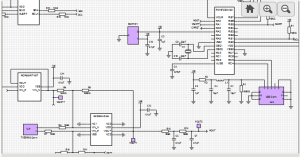Summary
The MCP6V01 auto-zeroed op-amp features an ultra low offset voltage (VOS) and high common mode rejection ratio (CMRR), which makes it applicable to temperature measurement. The MCP6V01 thermocouple auto-zeroed reference design demonstrates how to measure electromotive force (EMF) voltage at the cold junction of the thermocouple in order to accurately measure temperature at the hot junction.
The difference amplifier is implemented using the MCP6V01 and 0.1% tolerance resistors. It amplifies the EMF voltage at the cold junction of the thermocouple. The MCP9800 senses temperature at the type K thermocouple’s connector. It should be located as close as possible to the connector on the PCB. This measurement is used to perform cold junction compensation for the thermocouple measurement. The MCP1541 provides a VREF (4.1V) to the internal 10-Bit ADC of the PIC18F2550 and sets the reference voltage for the difference amplifier. The CVREF is the internal comparator voltage reference of PIC18F2550, which is a 16-tap resistor ladder network that provides a selectable reference voltage. The MCP6001 buffer amplifier eliminates the voltage reference output impedance problem and produces the voltage VSHIFT.
The 2nd order RC low-pass filter that is implemented in this circuit can remove the high frequency noise and aliasing at the ADC input. The ADC of PIC18F2550 completes the analog-to-digital conversion. The data will be transferred to the PC using the USB interface. The thermal management software on PC is used to perform data display to show the real-time temperature and apply cold junction compensation and data linearization to determine the actual temperature of the thermocouple’s hot junction (weld bead).
For More Details: Thermocouple Auto-Zeroed Reference Design

